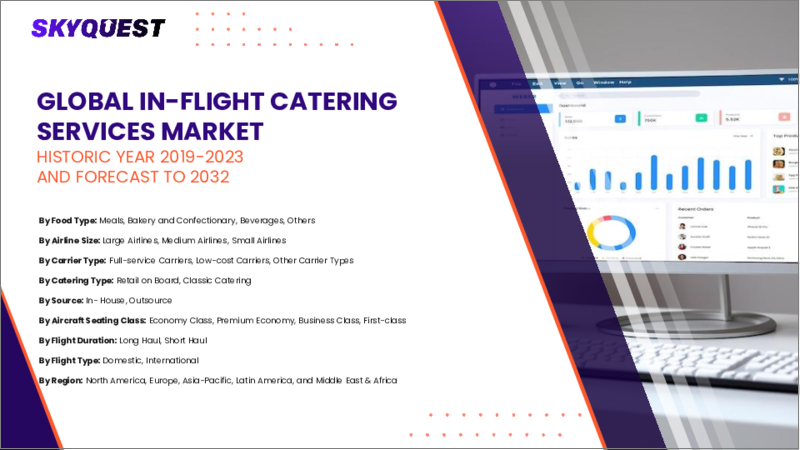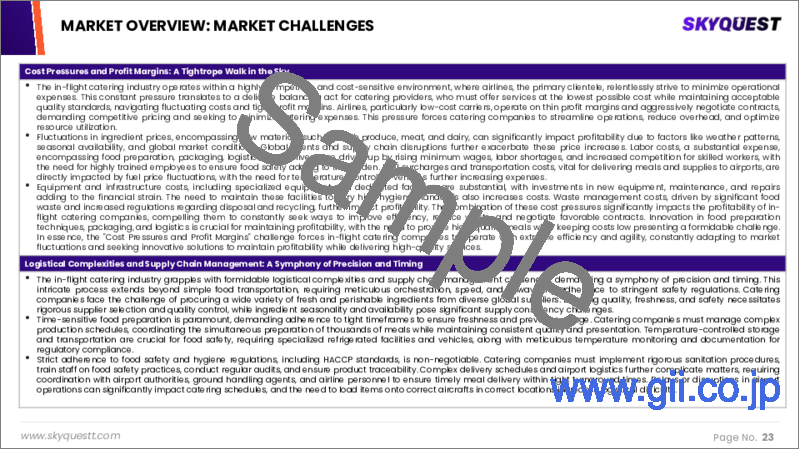|
|
市場調査レポート
商品コード
1655914
機内食サービス市場規模、シェア、成長分析:食品タイプ別、フライトタイプ別、航空機座席別、ケータリングタイプ別、飛行時間別、地域別 - 産業予測 2025~2032年In-Flight Catering Services Market Size, Share, and Growth Analysis, By Food Type, By Flight Type, By Aircraft Seating, By Catering Type, By Flight Duration, By Region - Industry Forecast 2025-2032 |
||||||
|
|||||||
| 機内食サービス市場規模、シェア、成長分析:食品タイプ別、フライトタイプ別、航空機座席別、ケータリングタイプ別、飛行時間別、地域別 - 産業予測 2025~2032年 |
|
出版日: 2025年02月11日
発行: SkyQuest
ページ情報: 英文 202 Pages
納期: 3~5営業日
|
全表示
- 概要
- 目次
機内食サービスの世界市場規模は2023年に361億米ドルと評価され、2024年の379億8,000万米ドルから2032年には569億7,000万米ドルに成長し、予測期間(2025-2032年)のCAGRは5.2%で成長する見通しです。
世界の機内食サービス市場は、航空会社の慣行の進化、旅客の嗜好の変化、環境に配慮した取り組みによって大きな変革が起きています。旅行者は現在、新鮮で多様性に富み、より健康的な食事の選択肢を求めるようになり、航空会社は植物性、グルテンフリー、減塩の食事を提供するようになっています。技術の進歩も業界を再構築しており、ケータリングプロバイダーは、自動化、革新的なキッチン用品、モバイル事前注文アプリを通じて、在庫の最適化、効率の向上、提供内容の個別化を実現しています。COVID-19の流行はケータリング戦略にも影響を与え、衛生面やタッチレスソリューションが重視され、事前包装された食事へのシフトが進んでいます。航空会社が変動する規制や旅行者の嗜好に適応するにつれ、ケータリング業務における柔軟性が重要な傾向として浮上し、機内食の風景を再構築しています。
目次
イントロダクション
- 調査の目的
- 調査範囲
- 定義
調査手法
- 情報調達
- 二次と一次データの方法
- 市場規模予測
- 市場の前提条件と制限
エグゼクティブサマリー
- 世界市場の見通し
- 供給と需要の動向分析
- セグメント別機会分析
市場力学と見通し
- 市場概要
- 市場規模
- 市場力学
- 促進要因と機会
- 抑制要因と課題
- ポーターの分析
主な市場の考察
- 重要成功要因
- 競合の程度
- 主な投資機会
- 市場エコシステム
- 市場の魅力指数(2024年)
- PESTEL分析
- マクロ経済指標
- バリューチェーン分析
- 価格分析
機内食サービス市場規模:食品タイプ別& CAGR(2025-2032)
- 市場概要
- 食事
- パン・菓子
- 飲料
- その他の食品
機内食サービス市場規模:フライトタイプ別& CAGR(2025-2032)
- 市場概要
- フルサービスキャリア
- 格安航空会社
- その他のフライトタイプ
機内食サービス市場規模:航空機座席別& CAGR(2025-2032)
- 市場概要
- エコノミークラス
- ビジネスクラス
- ファーストクラス
機内食サービス市場規模:ケータリングタイプ別& CAGR(2025-2032)
- 市場概要
- 飛行機の中の小売り
- クラシックケータリング
機内食サービス市場規模:飛行時間別& CAGR(2025-2032)
- 市場概要
- 長距離
- 短距離
機内食サービス市場規模:地域別& CAGR(2025-2032)
- 北米
- 米国
- カナダ
- 欧州
- ドイツ
- スペイン
- フランス
- 英国
- イタリア
- その他欧州地域
- アジア太平洋地域
- 中国
- インド
- 日本
- 韓国
- その他アジア太平洋地域
- ラテンアメリカ
- ブラジル
- その他ラテンアメリカ地域
- 中東・アフリカ
- GCC諸国
- 南アフリカ
- その他中東・アフリカ
競合情報
- 上位5社の比較
- 主要企業の市場ポジショニング(2024年)
- 主な市場企業が採用した戦略
- 最近の市場動向
- 企業の市場シェア分析(2024年)
- 主要企業の企業プロファイル
- 企業の詳細
- 製品ポートフォリオ分析
- 企業のセグメント別シェア分析
- 収益の前年比比較(2022-2024)
主要企業プロファイル
- Lufthansa Flight Kitchen(Germany)
- Newrest(France)
- SATS Ltd.(Singapore)
- DNATA(United Arab Emirates)
- Flying Food Group(US)
- Do & Co(Austria)
- Emirates Flight Catering(United Arab Emirates)
- Gate Gourmet(Switzerland)
- Sodexo(France)
- Compass Group(UK)
- Aramark(US)
- Elior Group(France)
- Compass Group USA(US)
- Alpen Catering(Germany)
- Do & Co(Austria)
- Servair(France)
- Casino Air Caterers & Flight Services(CAFS)(France)
- Flying Food Group(US)
結論と提言
Global In-Flight Catering Services Market size was valued at USD 36.1 billion in 2023 and is poised to grow from USD 37.98 billion in 2024 to USD 56.97 billion by 2032, growing at a CAGR of 5.2% during the forecast period (2025-2032).
The global in-flight catering services market is experiencing significant transformation driven by evolving airline practices, changing passenger preferences, and green initiatives. Travelers now seek fresh, diverse, and healthier meal options that align with their dietary needs, encouraging airlines to offer plant-based, gluten-free, and low-sodium meals. Technological advancements are also reshaping the industry, enabling catering providers to optimize inventory, enhance efficiency, and personalize offerings through automation, innovative kitchenware, and mobile pre-ordering apps. The COVID-19 pandemic has further influenced catering strategies, emphasizing hygiene and touchless solutions, with a shift towards pre-packaged meals. As airlines adapt to fluctuating regulations and travel preferences, flexibility in catering operations has emerged as a crucial trend, reshaping the landscape of in-flight dining.
Top-down and bottom-up approaches were used to estimate and validate the size of the Global In-Flight Catering Services market and to estimate the size of various other dependent submarkets. The research methodology used to estimate the market size includes the following details: The key players in the market were identified through secondary research, and their market shares in the respective regions were determined through primary and secondary research. This entire procedure includes the study of the annual and financial reports of the top market players and extensive interviews for key insights from industry leaders such as CEOs, VPs, directors, and marketing executives. All percentage shares split, and breakdowns were determined using secondary sources and verified through Primary sources. All possible parameters that affect the markets covered in this research study have been accounted for, viewed in extensive detail, verified through primary research, and analyzed to get the final quantitative and qualitative data.
Global In-Flight Catering Services Market Segments Analysis
Global In-Flight Catering Services Market is segmented by Food Type, Flight Type, Aircraft Seating, Catering Type, Flight Duration and region. Based on Food Type, the market is segmented into Meals, Bakery and Confectionary, Beverages and Other Food Types. Based on Flight Type, the market is segmented into Full-Service Carriers, Low-Cost Carriers and Other Flight Types. Based on Aircraft Seating, the market is segmented into Economy Class, Business Class and First Class. Based on Catering Type, the market is segmented into Retail on Board and Classic Catering. Based on Flight Duration, the market is segmented into Long Haul and Short Haul. Based on region, the market is segmented into North America, Europe, Asia Pacific, Latin America and Middle East & Africa.
Driver of the Global In-Flight Catering Services Market
The Global In-Flight Catering Services market is driven by an escalating demand for luxury and comfort among air travelers, prompting airlines to invest more heavily in high-quality and diverse in-flight meal options. This trend is particularly pronounced among business and first-class passengers, who increasingly anticipate gourmet dining experiences and personalized service during their flights. Consequently, catering companies are adapting their offerings to meet these evolving expectations, focusing on enhancing the quality of meals and the overall dining experience to satisfy the discerning tastes of travelers seeking exceptional service while in the air.
Restraints in the Global In-Flight Catering Services Market
The Global In-Flight Catering Services market faces certain constraints due to limited air-travel space and the short duration of flights. These factors restrict the range of meal options that can adhere to high-quality standards. Consequently, airline operators encounter challenges in providing personalized or premium catering experiences, which may negatively impact passenger satisfaction. This limitation can hinder market growth potential, particularly on shorter routes where the ability to offer diverse and appealing meal choices is essential for enhancing the overall travel experience and fostering customer loyalty in the highly competitive aviation sector.
Market Trends of the Global In-Flight Catering Services Market
The Global In-Flight Catering Services market is witnessing a significant trend towards sustainable catering solutions, driven by heightened consumer awareness and demand for eco-friendly practices. Airlines are increasingly adopting eco-conscious approaches, such as utilizing biodegradable packaging, sourcing ingredients locally, and minimizing food waste. This shift not only aligns with environmental sustainability goals but also enhances passenger satisfaction by catering to their preferences for responsible travel. Consequently, airlines are making substantial investments in green practices, positioning themselves competitively in the market while contributing positively to global environmental initiatives. This trend reflects a broader commitment within the aviation industry to integrate sustainability into all operational aspects.
Table of Contents
Introduction
- Objectives of the Study
- Scope of the Report
- Definitions
Research Methodology
- Information Procurement
- Secondary & Primary Data Methods
- Market Size Estimation
- Market Assumptions & Limitations
Executive Summary
- Global Market Outlook
- Supply & Demand Trend Analysis
- Segmental Opportunity Analysis
Market Dynamics & Outlook
- Market Overview
- Market Size
- Market Dynamics
- Drivers & Opportunities
- Restraints & Challenges
- Porters Analysis
- Competitive rivalry
- Threat of substitute
- Bargaining power of buyers
- Threat of new entrants
- Bargaining power of suppliers
Key Market Insights
- Key Success Factors
- Degree of Competition
- Top Investment Pockets
- Market Ecosystem
- Market Attractiveness Index, 2024
- PESTEL Analysis
- Macro-Economic Indicators
- Value Chain Analysis
- Pricing Analysis
Global In-Flight Catering Services Market Size by Food Type & CAGR (2025-2032)
- Market Overview
- Meals
- Bakery and Confectionary
- Beverages
- Other Food Types
Global In-Flight Catering Services Market Size by Flight Type & CAGR (2025-2032)
- Market Overview
- Full-Service Carriers
- Low-Cost Carriers
- Other Flight Types
Global In-Flight Catering Services Market Size by Aircraft Seating & CAGR (2025-2032)
- Market Overview
- Economy Class
- Business Class
- First Class
Global In-Flight Catering Services Market Size by Catering Type & CAGR (2025-2032)
- Market Overview
- Retail on Board
- Classic Catering
Global In-Flight Catering Services Market Size by Flight Duration & CAGR (2025-2032)
- Market Overview
- Long Haul
- Short Haul
Global In-Flight Catering Services Market Size & CAGR (2025-2032)
- North America (Food Type, Flight Type, Aircraft Seating, Catering Type, Flight Duration)
- US
- Canada
- Europe (Food Type, Flight Type, Aircraft Seating, Catering Type, Flight Duration)
- Germany
- Spain
- France
- UK
- Italy
- Rest of Europe
- Asia Pacific (Food Type, Flight Type, Aircraft Seating, Catering Type, Flight Duration)
- China
- India
- Japan
- South Korea
- Rest of Asia-Pacific
- Latin America (Food Type, Flight Type, Aircraft Seating, Catering Type, Flight Duration)
- Brazil
- Rest of Latin America
- Middle East & Africa (Food Type, Flight Type, Aircraft Seating, Catering Type, Flight Duration)
- GCC Countries
- South Africa
- Rest of Middle East & Africa
Competitive Intelligence
- Top 5 Player Comparison
- Market Positioning of Key Players, 2024
- Strategies Adopted by Key Market Players
- Recent Developments in the Market
- Company Market Share Analysis, 2024
- Company Profiles of All Key Players
- Company Details
- Product Portfolio Analysis
- Company's Segmental Share Analysis
- Revenue Y-O-Y Comparison (2022-2024)
Key Company Profiles
- Lufthansa Flight Kitchen (Germany)
- Company Overview
- Business Segment Overview
- Financial Updates
- Key Developments
- Newrest (France)
- Company Overview
- Business Segment Overview
- Financial Updates
- Key Developments
- SATS Ltd. (Singapore)
- Company Overview
- Business Segment Overview
- Financial Updates
- Key Developments
- DNATA (United Arab Emirates)
- Company Overview
- Business Segment Overview
- Financial Updates
- Key Developments
- Flying Food Group (US)
- Company Overview
- Business Segment Overview
- Financial Updates
- Key Developments
- Do & Co (Austria)
- Company Overview
- Business Segment Overview
- Financial Updates
- Key Developments
- Emirates Flight Catering (United Arab Emirates)
- Company Overview
- Business Segment Overview
- Financial Updates
- Key Developments
- Gate Gourmet (Switzerland)
- Company Overview
- Business Segment Overview
- Financial Updates
- Key Developments
- Sodexo (France)
- Company Overview
- Business Segment Overview
- Financial Updates
- Key Developments
- Compass Group (UK)
- Company Overview
- Business Segment Overview
- Financial Updates
- Key Developments
- Aramark (US)
- Company Overview
- Business Segment Overview
- Financial Updates
- Key Developments
- Elior Group (France)
- Company Overview
- Business Segment Overview
- Financial Updates
- Key Developments
- Compass Group USA (US)
- Company Overview
- Business Segment Overview
- Financial Updates
- Key Developments
- Alpen Catering (Germany)
- Company Overview
- Business Segment Overview
- Financial Updates
- Key Developments
- Do & Co (Austria)
- Company Overview
- Business Segment Overview
- Financial Updates
- Key Developments
- Servair (France)
- Company Overview
- Business Segment Overview
- Financial Updates
- Key Developments
- Casino Air Caterers & Flight Services (CAFS) (France)
- Company Overview
- Business Segment Overview
- Financial Updates
- Key Developments
- Flying Food Group (US)
- Company Overview
- Business Segment Overview
- Financial Updates
- Key Developments





